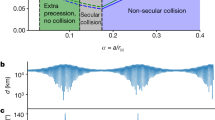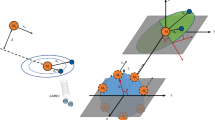Abstract
Asteroids that follow similar orbits may have a dynamical connection as their current paths could be the result of a past interaction with a massive perturber. The pair of extreme trans-Neptunian objects or ETNOs (474640) 2004 VN112–2013 RF98 exhibits peculiar relative orbital properties, including a difference in longitude of the ascending node of just 1\(\stackrel {\circ }{\text{.}}\)61 and 3\(\stackrel {\circ }{\text{.}}\)99 in inclination. In addition, their reflectance spectra are similar in the visible portion of the spectrum. The origin of these similarities remains unclear. Neglecting observational bias, viable scenarios that could explain this level of coincidence include fragmentation and binary dissociation. Here, we present results of extensive direct \(N\)-body simulations of close encounters between wide binary ETNOs and one trans-Plutonian planet. We find that wide binary ETNOs can dissociate during such interactions and the relative orbital properties of the resulting unbound couples match reasonably well those of several pairs of known ETNOs, including 474640–2013 RF98. The possible presence of former binaries among the known ETNOs has strong implications for the interpretation of the observed anisotropies in the distributions of the directions of their orbital poles and perihelia.













Similar content being viewed by others
Notes
For the numerical experiments lasting 24 000 yr, Fig. 4, 23.3% (116 561) resulted in binary dissociation, out of these, 95.0% (110 752) had positive relative energy; the fraction of ejections/collisions/captures was 1.3%.
References
Aarseth, S.J.: Gravitational \(N\)-Body Simulations. Cambridge Univ. Press, Cambridge (2003)
Agnor, C.B., Hamilton, D.P.: Nature 441, 192 (2006)
Astakhov, S.A., Lee, E.A., Farrelly, D.: Mon. Not. R. Astron. Soc. 360, 401 (2005)
Bailey, V., et al.: Astrophys. J. 780, L4 (2014)
Bannister, M.T., et al.: Astron. J. 153, 262 (2017)
Barr, A.C., Schwamb, M.E.: Mon. Not. R. Astron. Soc. 460, 1542 (2016)
Basu, D.: J. Am. Stat. Assoc. 75, 575 (1980)
Batygin, K., Brown, M.E.: Astron. J. 151, 22 (2016)
Bogart, R.S., Noerdlinger, P.D.: Astron. J. 87, 911 (1982)
Brady, J.L.: Publ. Astron. Soc. Pac. 84, 314 (1972)
Bromley, B.C., Kenyon, S.J.: Astrophys. J. 826, 64 (2016)
Brown, M.E.: Astron. J. 154, 65 (2017)
Brown, M.E., Batygin, K.: Astrophys. J. 824, L23 (2016)
Brown, M.E., Trujillo, C., Rabinowitz, D.: Astrophys. J. 617, 645 (2004a)
Brown, M.E., Trujillo, C.A., Rabinowitz, D., Stansberry, J., Bertoldi, F., Koresko, C.D.: Bull. Am. Astron. Soc. 36, 03.01 (2004b)
Brown, M.E., Trujillo, C.A., Rabinowitz, D.L.: Astrophys. J. 635, L97 (2005)
Brown, M.E., et al.: Astrophys. J. 639, L43 (2006)
Brown, M.E., et al.: Astron. J. 149, 69 (2015)
Chambers, J.E.: Mon. Not. R. Astron. Soc. 304, 793 (1999)
Chiang, E.I., Brown, M.E.: Astron. J. 118, 1411 (1999)
de la Fuente Marcos, C., de la Fuente Marcos, R.: Mon. Not. R. Astron. Soc. 427, 728 (2012)
de la Fuente Marcos, C., de la Fuente Marcos, R.: Mon. Not. R. Astron. Soc. 443, L59 (2014)
de la Fuente Marcos, C., de la Fuente Marcos, R.: Mon. Not. R. Astron. Soc. 453, 1288 (2015)
de la Fuente Marcos, C., de la Fuente Marcos, R.: Mon. Not. R. Astron. Soc. 459, L66 (2016a)
de la Fuente Marcos, C., de la Fuente Marcos, R.: Mon. Not. R. Astron. Soc. 460, L64 (2016b)
de la Fuente Marcos, C., de la Fuente Marcos, R.: Mon. Not. R. Astron. Soc. 462, 1972 (2016c)
de la Fuente Marcos, C., de la Fuente Marcos, R.: Mon. Not. R. Astron. Soc. 471, L61 (2017)
de la Fuente Marcos, C., de la Fuente Marcos, R., Aarseth, S.J.: Mon. Not. R. Astron. Soc. 446, 1867 (2015)
de la Fuente Marcos, C., de la Fuente Marcos, R., Aarseth, S.J.: Mon. Not. R. Astron. Soc. 460, L123 (2016)
de León, J., de la Fuente Marcos, C., de la Fuente Marcos, R.: MPEC 2016-U18 (2016)
de León, J., de la Fuente Marcos, C., de la Fuente Marcos, R.: Mon. Not. R. Astron. Soc. 467, L66 (2017)
Fernández, J.A.: Mon. Not. R. Astron. Soc. 192, 481 (1980)
Fienga, A., Laskar, J., Manche, H., Gastineau, M.: Astron. Astrophys. 587, L8 (2016)
Fisher, R.A.: The Design of Experiments. Oliver and Boyd, Edinburgh (1935)
Fraser, W.C., Brown, M.E.: Astrophys. J. 749, 33 (2012)
Fraser, W.C., et al.: Nat. Astron. 1, 0088 (2017a)
Fraser, W.C., et al.: Nat. Astron. 1, 0138 (2017b)
Giorgini, J.D., et al.: Bull. Am. Astron. Soc. 28, 1158 (1996)
Giorgini, J.: In: Capitaine, N. (ed.) Proceedings of the Journées 2010 “Systèmes de référence spatio-temporels” (JSR2010): New Challenges for Reference Systems and Numerical Standards in Astronomy, p. 87. Observatoire de Paris, Paris (2011)
Giorgini, J.D.: IAU Gen. Assem. Meet. XXIX 22, 2256293 (2015)
Gladman, B., Holman, M., Grav, T., Kavelaars, J., Nicholson, P., Aksnes, K., Petit, J.-M.: Icarus 157, 269 (2002)
Goldreich, P., Lithwick, Y., Sari, R.: Nature 420, 643 (2002)
Gomes, R.S., Soares, J.S., Brasser, R.: Icarus 258, 37 (2015)
Grundy, W.M., Noll, K.S., Buie, M.W., Benecchi, S.D., Stephens, D.C., Levison, H.F.: Icarus 200, 627 (2009)
Grundy, W.M., et al.: Icarus 213, 678 (2011)
Harmon, J.K., Nolan, M.C., Giorgini, J.D., Howell, E.S.: Icarus 207, 499 (2010)
Hills, J.G.: Astron. J. 86, 1730 (1981)
Holman, M.J., Payne, M.J.: Astron. J. 152, 80 (2016a)
Holman, M.J., Payne, M.J.: Astron. J. 152, 94 (2016b)
Howard, A.W., et al.: Science 330, 653 (2010)
Jacobson, S.A.: In: Chesley, S.R., Morbidelli, A., Jedicke, R., Farnocchia, D. (eds.) Asteroids: New Observations, New Models. IAU Symp., vol. 318, p. 55. Cambridge Univ. Press, Cambridge (2016)
JeongAhn, Y., Malhotra, R.: Astron. J. 153, 235 (2017)
Jewitt, D., Luu, J.: Nature 362, 730 (1993). 1993
Jílková, L., Portegies Zwart, S., Pijloo, T., Hammer, M.: Mon. Not. R. Astron. Soc. 453, 3157 (2015)
Keane, J.T., Matsuyama, I.: Lunar Planet. Sci. Conf. Abstr. 46, 2996 (2015)
Kenyon, S.J., Bromley, B.C.: Astrophys. J. 806, 42 (2015)
Kenyon, S.J., Bromley, B.C.: Astrophys. J. 825, 33 (2016)
Kern, S.D., Adams, E., Buie, M.W., Millis, R.L., Marsden, B.G.: MPEC 2006-O52 (2006)
Kiss, C., et al.: Astrophys. J. 838, L1 (2017)
Kuz’michev, V.V., Tomanov, V.P.: Astron. Lett. 32, 353 (2006)
Larsen, J.A., et al.: Astron. J. 133, 1247 (2007)
Lawler, S.M., Shankman, C., Kaib, N., Bannister, M.T., Gladman, B., Kavelaars, J.J.: Astron. J. 153, 33 (2017)
Levison, H.F., Dones, L., Duncan, M.J.: Astron. J. 121, 2253 (2001)
Levison, H.F., Morbidelli, A., Van Laerhoven, C., Gomes, R., Tsiganis, K.: Icarus 196, 258 (2008)
Li, G., Adams, F.C.: Astrophys. J. 823, L3 (2016)
Luhman, K.L.: Astrophys. J. 781, 4 (2014)
Lykawka, P.S., Mukai, T.: Astron. J. 135, 1161 (2008)
Makino, J.: Astrophys. J. 369, 200 (1991)
Malhotra, R.: Astrophys. J. 808, 71 (2015)
Malhotra, R., Volk, K., Wang, X.: Astrophys. J. 824, L22 (2016)
Milani, A., Chesley, S.R., Valsecchi, G.B.: Astron. Astrophys. 346, L65 (1999)
Milani, A., Cellino, A., Knežević, Z., Novaković, B., Spoto, F., Paolicchi, P.: Icarus 239, 46 (2014)
Millholland, S., Laughlin, G.: Astron. J. 153, 91 (2017)
Millis, R.L., Clancy, K.B.: IAU Circ. 8251, 2 (2003)
Morbidelli, A., Levison, H.F.: Astron. J. 128, 2564 (2004)
Mustill, A.J., Raymond, S.N., Davies, M.B.: Mon. Not. R. Astron. Soc. 460, L109 (2016)
Naud, M.-E., et al.: Astrophys. J. 787, 5 (2014)
Nesvorný, D., Youdin, A.N., Richardson, D.C.: Astron. J. 140, 785 (2010)
Nesvorný, D., Brož, M., Carruba, V.: In: Michel, P., DeMeo, F.E., Bottke, W.F. Jr. (eds.) Asteroids IV. University of Arizona Space Science Series, p. 297. Univ. of Arizona Press, Tucson (2015)
Noll, K.S., et al.: Astron. J. 124, 3424 (2002)
Noll, K.S., Grundy, W.M., Chiang, E.I., Margot, J.-L., Kern, S.D.: In: Barucci, M.A., Boehnhardt, H., Cruikshank, D.P., Morbidelli, A., Dotson, R. (eds.) The Solar System Beyond Neptune. University of Arizona Space Science Series, p. 345. Univ. of Arizona Press, Tucson (2008)
Oort, J.H.: Bull. Astron. Inst. Neth. 11, 91 (1950)
Öpik, E.J.: Proc. R. Ir. Acad. A 54, 165 (1951)
Öpik, E.J.: Ir. Astron. J. 10, 35 (1971)
Ortiz, J.L., et al.: Mon. Not. R. Astron. Soc. 419, 2315 (2012)
Parker, A.H., Kavelaars, J.J.: Astrophys. J. 722, L204 (2010)
Parker, A.H., Kavelaars, J.J., Petit, J.-M., Jones, L., Gladman, B., Parker, J.: Astrophys. J. 743, 1 (2011)
Parker, A.H., Buie, M.W., Grundy, W.M., Noll, K.S.: Astrophys. J. 825, L9 (2016)
Petit, J.-M., Mousis, O.: Icarus 168, 409 (2004)
Petit, J.-M., et al.: Science 322, 432 (2008)
Radzievskij, V.V., Artem’ev, A.V., Dolgopolova, E.A., Kokurina, L.N., Korniyasova, E.V.: Sol. Syst. Res. 27, 359 (1994)
Saillenfest, M., Fouchard, M., Tommei, G., Valsecchi, G.B.: Celest. Mech. Dyn. Astron. 127, 477 (2017)
Scheeres, D.J.: Celest. Mech. Dyn. Astron. 94, 317 (2006)
Scheeres, D.J., Ostro, S.J., Werner, R.A., Asphaug, E., Hudson, R.S.: Icarus 147, 106 (2000)
Schlichting, H.E., Sari, R.: Astrophys. J. 673, 1218 (2008)
Seidelmann, P.K.: Astron. J. 76, 740 (1971)
Shankman, C., Kavelaars, J.J., Lawler, S.M., Gladman, B.J., Bannister, M.T.: Astron. J. 153, 63 (2017a)
Shankman, C., et al.: Astron. J. 154, 50 (2017b)
Sharma, I., Jenkins, J.T., Burns, J.A.: Icarus 183, 312 (2006)
Sheppard, S.S.: Astron. J. 139, 1394 (2010)
Sheppard, S.S., Trujillo, C.: Astron. J. 152, 221 (2016)
Sheppard, S.S., Trujillo, C., Tholen, D.: AAS/Div. Planet. Sci. Meet. Abstr. 47, 203.07 (2015)
Sierks, H., et al.: Science 347, a1044 (2015)
Silburt, A., Gaidos, E., Wu, Y.: Astrophys. J. 799, 180 (2015)
Standish, E.M.: JPL planetary and Lunar ephemerides, DE405/LE405. Interoffice Memo. 312.F-98-048, NASA JPL (1998)
Trujillo, C.A., Sheppard, S.S.: Nature 507, 471 (2014)
Vokrouhlický, D., Nesvorný, D., Levison, H.F.: Astron. J. 136, 1463 (2008)
Volk, K., Malhotra, R.: Astron. J. 154, 62 (2017)
Wall, J.V., Jenkins, C.R.: Practical Statistics for Astronomers, 2nd edn. Cambridge Univ. Press, Cambridge (2012)
Weidenschilling, S.J.: Icarus 160, 212 (2002)
Welch, W.J.: J. Am. Stat. Assoc. 85, 693 (1990)
Wetherill, G.W.: J. Geophys. Res. 72, 2429 (1967)
Acknowledgements
We thank the referee, J.A. Fernández, for a critical, constructive and helpful review, an anonymous referee for another review, and J. de León, J.-M. Petit, M.T. Bannister, D.P. Whitmire, G. Carraro, D. Fabrycky, A.V. Tutukov, S. Mashchenko, S. Deen and J. Higley for comments on ETNOs and trans-Plutonian planets. This work was partially supported by the Spanish ‘Ministerio de Economía y Competitividad’ (MINECO) under grant ESP2014-54243-R. CdlFM and RdlFM thank A.I. Gómez de Castro, I. Lizasoain and L. Hernández Yáñez of the Universidad Complutense de Madrid (UCM) for providing access to computing facilities. Part of the calculations and the data analysis were completed on the EOLO cluster of the UCM, and CdlFM and RdlFM thank S. Cano Alsúa for his help during this stage. EOLO, the HPC of Climate Change of the International Campus of Excellence of Moncloa, is funded by the MECD and MICINN. This is a contribution to the CEI Moncloa. In preparation of this paper, we made use of the NASA Astrophysics Data System, the ASTRO-PH e-print server and the MPC data server.
Author information
Authors and Affiliations
Corresponding author
Rights and permissions
About this article
Cite this article
de la Fuente Marcos, C., de la Fuente Marcos, R. & Aarseth, S.J. Binary stripping as a plausible origin of correlated pairs of extreme trans-Neptunian objects. Astrophys Space Sci 362, 198 (2017). https://doi.org/10.1007/s10509-017-3181-1
Received:
Accepted:
Published:
DOI: https://doi.org/10.1007/s10509-017-3181-1




